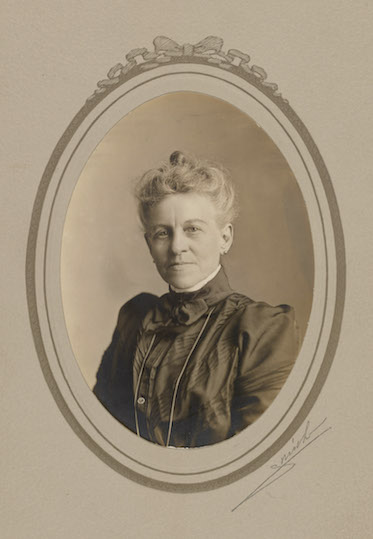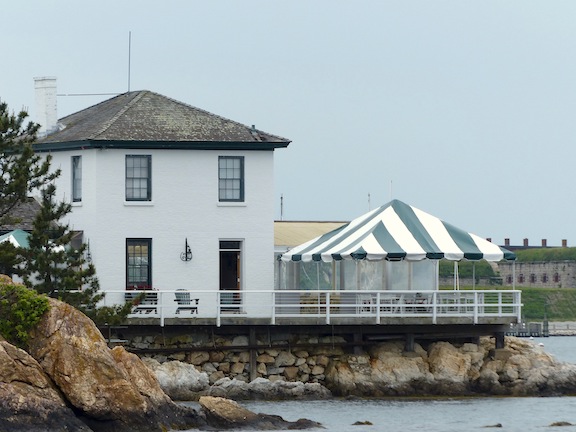
Today is Ida Lewis’s 175th birthday. Google has marked the occasion with a google doodle. Ida was famous in her day for her numerous lifesaving rescues at Lime Rock Light Station in Newport, Rhode Island. She received a gold lifesaving medal in 1881 and Lime Rock was renamed in her honor in 1924.
Idawalley Zorada Lewis, called Ida, was born in Newport, Rhode Island, in 1842. Her father, Captain Hosea Lewis, was a coast pilot whose health was declining. In 1853 he became the first keeper of nearby Lime Rock beacon on a tiny island a third of a mile from the shore of Newport. At first there was only a temporary lantern and a rough shed that provided shelter when the keeper was on the island in bad weather. Lewis’s family remained in the old part of Newport until 1857, when a Greek Revival building with a hip roof was constructed on the island. Lewis moved his family into the lighthouse when Ida, his eldest child, was 15.
Hosea Lewis had been at Lime Rock less than four months when he was stricken by a disabling stroke. Like many wives and daughters of lighthouse keepers before and after, Ida expanded her domestic duties, now increased by the care of her invalid father and a seriously ill sister, to include the care of the light—filling the lamp with oil at sundown and again at midnight, trimming the wick, and extinguishing the light at dawn. All these responsibilities precluded further formal education for Ida.
Since Lime Rock was completely surrounded by water, the only way to reach the mainland was by boat. In the mid-nineteenth century it was highly unusual for a woman to handle a boat, but Ida, the oldest of four children, rowed her siblings to school every weekday and fetched needed supplies from the town. The wooden boat was heavy, but she became very skillful in handling it. (An article in Harper’s Weekly, written after Ida had made several daring rescues, debated whether it was “feminine” for women to row boats, but concluded that none but a “donkey” would consider it “unfeminine” to save lives.) Ida was also reputed to be the best swimmer in all Newport.

Ida’s skill at the oars was regularly tested. During her first year at Lime Rock, four young men who were out sailing nearly drowned. One of them had foolishly shimmied up the mast and rocked the boat to tease his companions. The boat capsized, and four boys who couldn’t swim clung to the overturned hull, shouting for help. Ida heard them and rowed to their rescue. In their terror, they almost dragged her overboard, but she pulled all four over the stern into her boat and returned them to land. This was only the first of a number of rescues that later made Ida famous.

Ida and her mother Zorada tended the Lime Rock Light for her father from 1857 until 1872, when he died. Her mother was appointed keeper until 1879, although Ida continued to do the keeper’s work. Then Ida received the official appointment and her own salary ($500 a year). She continued at her post until her own death in 1911. On the night of her death the bells on all the vessels anchored in Newport Harbor were tolled in her memory.
On September 28, 1881,William Windom, secretary of the Light-House Board, wrote to Ida Lewis as follows:
I have the honor to transmit herewith the gold medal which has been awarded to you under authority of the Act of Congress of June 20, 1874, in recognition of your services in rescuing from drowning at the peril of your life, two soldiers belonging to the garrison of Fort Adams.
It appears from the evidence submitted to the Department in this connection, that on February 4th last, these men were crossing between Lime Rock light-house and the fort and the ice, being dangerously weak and rotten, gave way under their feet, and let them in. Hearing their cries for help, you ran from the light-house with a rope, one end of which you flung to them and standing upon the ice, in imminent danger of its giving way beneath you, and also of being dragged into the water, both men having hold of the line, you succeeded in pulling them out, one after the other. The rescue of one you effected entirely unaided; the second man you hauled from the broken ice, with the help of your brother, who arrived at the spot in time to render this assistance.
It is the testimony of the rescued men, and of the several eye-witnesses, that in this act you placed your life in great peril.
The papers before the Department in this case, cite the instances of no less than thirteen persons saved by you from drowning, at dates anterior to this occurrence, and it is stated that there are many more who do not appear in the record. These deeds have won for you a national distinction, and it is peculiarly appropriate that you should receive the national life-saving medal in commemoration of your brave acts as a life-saver, while it is an occasion for added satisfaction that such a memorial of unquestionable heroism should have been won by a woman. (Source: National Archives, Record Group 26, Letterbook 553.)

In 1927 the Bureau of Lighthouses removed the lens from the lantern and placed an automated beacon on a skeleton tower in front of the lighthouse. This light continued in service until 1963, when it was deactivated by the Coast Guard. Later the Newport Yacht Club bought the lighthouse and obtained permission from the Coast Guard to put a light back in the old lantern and maintain it as a private aid to navigation. Although adaptively used by the yacht club (and renamed the Ida Lewis Yacht Club), the building is virtually unaltered from the time that Ida Lewis lived there.
In 1995 the Coast Guard launched the first of a series of new keeper-class 175-foot coastal buoy tenders and named it Ida Lewis.
Submitted by Candace Clifford using excerpts from Women Who Kept the Lights: An Illustrated History of Female Lighthouse Keepers (Alexandria, Virginia: Cypress Communications, 2013), February 25, 2017
* * * *
U.S. Lighthouse Society News is produced by the U.S. Lighthouse Society to support lighthouse preservation, history, education and research. Please consider joining the U.S. Lighthouse Society if you are not already a member. If you have items of interest to the lighthouse community and its supporters, please email them to candace@uslhs.org.

Candace was the US Lighthouse Society historian from 2016 until she passed away in August 2018. For 30 years, her work involved lighthouse history. She worked with the National Park Service and the Council of American Maritime Museums. She was a noted author and was considered the most knowledgable person on lighthouse information at the National Archives. Books by Candace Clifford include: Women who Kept the Lights: a History of Thirty-eight Female Lighthouse Keepers , Mind the Light Katie, and Maine Lighthouses, Documentation of their Past.

